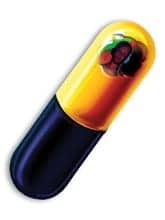By Gary Tufel

Testing for RA
Standard lab tests for RA include CBCs to check for low red-blood-cell counts, since anemia is common in patients with RA. The more aggressive the disease, the more severe the anemia. If white-blood-cell counts are high, infection may be present. A low white-blood-cell count may be caused by some medications, or it could suggest Felty’s syndrome, a complication of RA. Platelet counts can be elevated when inflammation is present in the body, as in RA.

The erythrocyte sedimentation rate (ESR) measures the speed at which red blood cells fall to the bottom of a test tube; the more rapidly red blood cells drop, the more inflammation is present in the body. A high ESR indicates inflammation. C-reactive protein (CRP) is elevated when inflammation is found in the body; the higher the level of CRP, the more disease activity is involved. Although ESR and CRP are general markers for inflammation, sometimes one will be raised when the other will not be. Rheumatologist Scott Zashin, MD, author of Arthritis Without Pain: The Miracle of TNF Blockers, says it is important to measure inflammation because it can be a predictor of joint damage.
Depending on the stage of their disease, a high percentage of people with RA have a specific autoantibody called rheumatoid factor (RF). The presence of high amounts of RF is correlated with severe disease. RF has been known for more than 50 years, and is part of the American College of Rheumatology criteria for RA.

In the last 5 years, a new marker to help diagnose RA was discovered: anticyclic citrullinated peptide (CCP), says Rufus Burlingame, PhD, senior scientist, INOVA Diagnostics. “The availability of new treatments has spurred interest in yet newer diagnostic procedures, especially anti-CCP testing. This is all because of the fantastic results obtained with recent treatments, such as anti-TNF (tumor necrosis factor) inhibitors,” he says.
The anti-CCP test works as follows: An autoantibody is directed against a peptide (a string of amino acids) containing an unusual amino acid called citrulline that is not normally present in peptides or proteins. The anti-CCP antibodies provide the basis for a test of importance in RA. They appear early in the course of RA and are present in 60%–80% of RA patients. Unlike RF, anti-CCP antibodies are very rarely found in people with diseases other than RA. This high specificity makes them a valuable tool to help diagnose RA. In addition, some patients who are negative for RF are positive for anti-CCP. The test for anti-CCP is therefore useful in patients with unexplained joint inflammation, especially when the traditional blood test for RF is negative. The point of this new test, Burlingame says, is to diagnose those with RA correctly and early.
Citrullinated proteins have been discovered in the joints of patients with RA but not in other forms of joint disease. This finding suggests a possible role for anti-CCP antibodies in the development of RA. Anti-CCP antibodies predict the eventual development of undifferentiated arthritis into RA. They also have prognostic value, since they are associated with a greater tendency toward more destructive forms of RA.

Hayes Wilson, MD, rheumatologist and medical adviser for the Arthritis Foundation, agrees that the anti-CCP diagnostic assay has been proven effective in determining whether or not patients have RA. A traditional assay, RF testing had been used more frequently until now, but it was not as accurate, says Wilson. Early in the course of RA, about half of patients test positive for RF, so it is not very sensitive early-on. Those who have had RA for 5 years or more have a 90% chance of having a positive RF, he says. Zashin adds that not all people with CCP will develop RA or bone damage, but those with CCP are at a higher risk.
Prior to the anti-CCP test, Burlingame says, older tests to help diagnose RA, such as the antiperinuclear factor and antikeratin immunofluorescent tests, also were measuring antibodies against citrullinated proteins. Both tests were technically difficult to perform and never became popular for general labs, so they were not commercialized. It was found that antiperinuclear factor and antikeratin are both really directed against filaggrin, meaning that the antikeratin test was misnamed, says Burlingame. In fact, these antibodies are only reactive against citrullinated filaggrin. This is an extremely specific type of antibody—the change of even a single atom can completely change what the antibody recognizes. A pioneer in this discovery was Walter van Venroij, says Burlingame. van Venroij worked with Euro Diagnostica to find a better citrullinated peptide and developed CCP2, which is now used by all commercial companies.
Anti-CCP occurs earlier in the course of RA than does RF. Any rheumatologist can now order anti-CCP—it is available at virtually all reference labs, say Zashin and Burlingame. Like RF testing, it is included in a standard blood test; and it is common, easily available, and inexpensive. Improvements in treating RA patients in the past 5 years have driven improvements in diagnosis, Burlingame says.
Other new diagnostic markers for RA are IgG and IgA RF. RF is usually considered of the IgM class, but there are techniques to measure IgG and IgA RF as well. Even though IgG and IgA RF are not as common in RA patients as IgM RF, they are more specific markers, and may be more correlated with severe disease, Burlingame says.
Several types of imaging studies, including x-rays, are used to gauge RA’s progress after it is diagnosed.
Early and Aggressive Treatment
TNF blockers are a key treatment for RA. Zashin says that nearly two of every three patients who try the medication get lasting relief from joint pain and inflammation. Known as biologic DMARDs (disease modifying antirheumatic drugs), these high-tech drugs inhibit the action of TNF, a protein that contributes to joint damage associated with rheumatoid arthritis, psoriatic arthritis, and ankylosing spondylitis. In the past few years, many clinicians have been using the anti-CCP assay for diagnoses, Zashin says.
Burlingame notes that Volume 21 of Clinical & Experimental Rheumatology, published in 2003 and consisting of 40 papers written by the heads of early RA clinics, posited that early and aggressive diagnosis and treatment of RA was now possible, as opposed to the very conservative treatment being done until that time. Treatments for RA have included anti-inflammatory drugs such as aspirin, as well as COX-2 selective inhibitors that are no longer available. Some antimalarial drugs also helped treat RA, but did not stop it completely. Other drugs, including some anticancer drugs, were effective but have potentially serious side effects, as did certain steroids such as Prednisone. Prednisone reduces inflammation but also has side effects depending on dose and duration of exposure.
Modern therapy has revolutionized treatment. Anti-TNF alpha inhibitors—taken intravenously once every 2 months—can actually stop the progression of RA in some patients. However, if there has already been severe bone damage, treatment can stop the progression of the disease, but it cannot reverse the damage. That’s why rheumatologists want to catch the disease early. And since these new biologic drugs cost upward of $10,000 per year, physicians want to avoid giving them to patients who don’t need them. The drugs also shut down the alpha branch of the immune system, making patients more susceptible to infections, especially of the lungs. It can even cause relapses of tuberculosis (TB) in those who have had TB.
What’s Needed
Wilson says he would like to see a perfect test with 100% specificity because the RF can also be found in lupus and other autoimmune diseases. Likewise, a test is needed to monitor the effectiveness of treatment once a positive RF is found. Tracking the progress of treatment is an art, not a science, so the best development would be a cure, not just treatment, according to Wilson. X-rays are often used to track the progress of RA, but, “We need something more precise for RA and not only for diagnosis but for treatment,” Wilson says. He’s not aware of any new developments, but he thinks biologics tests that monitor TNF might be a potential tool. For now, diagnosing RA patients remains a combination of techniques: visual examinations (swollen joint count, tenderness count); asking patients how they feel (“Can you comb your hair?” “How far can you walk?” “Can you bathe yourself?”); nonspecific tests such as for sedimentation rate; and global assessments (“How do you feel today?”). The various tests are then amalgamated into a score. He adds that most physicians have labs do anti-CCP and RF tests, which charge patients significantly more than a physician’s office lab would.
Burlingame says he would like to see improvements in determining which patients will progress to more aggressive forms of RA, and which ones will not get worse, so that appropriate treatment can be applied. INOVA is working with researchers to develop kits to measure levels of cartilage oligomeric matrix protein (COMP) in serum, because there are indications that increased levels of COMP in serum are associated with active joint destruction, Burlingame says. RA patients who are positive for a specific autoantibody like RF or anti-CCP, who have a marker for general inflammation like increased CRP or ESR, and who have high levels of serum COMP, may be at increased risk for erosive joint disease; while those with low levels of these markers have a low risk of erosive joint disease.
For Zashin, the key challenge is to find out which patients will progress and which will have joint damage. The CCP test can tell this, he says, but tests are still needed to tell whether a patient will respond to TNF blockers, who needs them, and which patients will experience side effects. Because the drugs are so expensive, it is important to sort out the patients who will benefit from these drugs. The answer in the future may be genetic testing to determine who is susceptible. However, no such testing is available at this time, Zashin says.
| What Is RA? According to the Arthritis Foundation, RA is characterized by inflammation of the lining, or synovium, of the joints. It can lead to long-term joint damage, resulting in chronic pain, loss of function, and disability. It often affects women between 30 and 50 years old, says rheumatologist Scott Zashin, MD, author of Arthritis Without Pain: The Miracle of TNF Blockers. RA progresses in three stages. The first is the swelling of the synovial lining, causing pain, warmth, stiffness, redness, and swelling around the joint. Second is the rapid division and growth of cells, which cause the synovium to thicken (pannus). In the third stage, the inflamed cells release enzymes that may digest bone and cartilage. This often causes the involved joint to lose its shape and alignment, causing more pain and loss of movement. RA is chronic, and frequent flares in disease activity can occur. Early diagnosis and aggessive treatment of RA is critical to limit joint damage. RA is also systemic. RA patients are more likely to have fatal heart problems if they also have swelling in joints or other tissues, according to research at the Mayo Clinic in Rochester, Minn. Though it is unclear why, researchers found the systemic inflammation common in RA could actually be contributing to the increased risk of fatal heart problems. They believe if the inflammation evidenced by swelling could be controlled, then the risk might be reduced. Arthritis can be of the inflammatory kind, as opposed to the type that inflicts wear and tear on joints. Zashin says that RA, which damages the joints relatively quickly, is an inflammatory arthritis, while osteoarthritis (OA) is less inflammatory. The most common arthritis is OA (about 10 times more common than RA), Zashin says. —GT |
Gary Tufel is a contributing writer for Clinical Lab Products.




